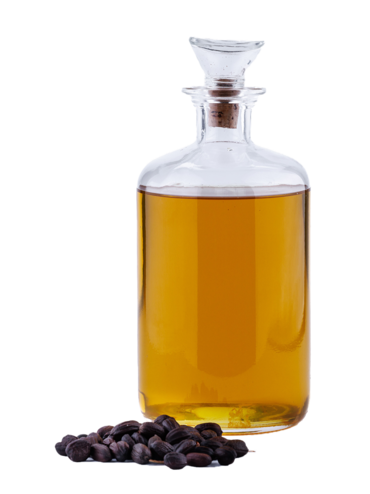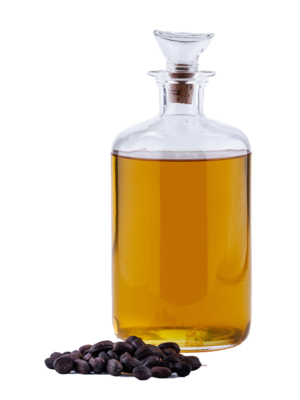Our Jojoba oil qualities
We carry Jojoba oil in the following qualities for you
All jojoba oil qualities offered by us are genetically unmodified.
Usage
|
Cosmetics |
Food |
Pharmaceutics |
|
|---|---|---|---|
| Jojoba oil (jojoba wax) refined | |||
| Jojoba oil (jojoba wax) virgin | |||
| Jojoba oil virgin low odour | |||
| Organic jojoba oil refined | |||
| Organic jojoba oil virgin | |||
| Organic jojoba oil virgin Demeter |
The oil is similar to human sebum, making it ideal for use on all skin types. Jojoba oil is only suitable for external use as it contains simmondsin, whose direct toxic effect is not yet known.

Jojoba bush & jojoba seed
Jojoba oil (jojoba wax) is obtained from the seeds of the jojoba bush (Simmondsia chinensis). This belongs to the clove-like plant family. The jojoba bush is considered the most robust plant of its kind. It grows in particularly dry areas and desert regions where conventional agriculture is not possible. Thanks to its tap roots, which are up to 10 metres deep, the jojoba shrub can reach even hard-to-reach groundwater and supplies itself with water. The shrub is extremely frugal and does not need rainwater even during long dry periods, only because it is supplied by its roots. The jojoba shrub reaches growth heights of 0.5 to 3 metres, usually 2.0 to 2.5 metres. It can be recognised by its leathery, evergreen leaves and the light, hard wood and smooth bark. The upright foliage leaves, which are arranged in opposite directions, are divided into a short leaf stem and a leaf blade. Its leaves are 2 to 6 centimetres long and 1 to 2 centimetres wide. The leaves are covered with a layer of wax to protect them from perspiration. They have a life span of one to three years, depending on the humidity conditions.
There are jojoba shrubs with exclusively female and exclusively male flowers, where the female plants stand alone, but the male plants grow together in groups. After pollination of the flowers, it takes about three to six months for the jojoba fruit to ripen. These fruits are nut-like seeds, also called nuts, are wrinkled, brown and their size is similar to that of an olive. They consist of up to 50 percent of the valuable jojoba oil.
It takes up to 4-6 years until the first harvest of jojoba fruits. The maximum yield is 12 years. In a natural environment, the shrubs can live up to 200 years.
Would you like to be informed about the general market situation of Jojoba oil and our other products?
subscribe to market reportCultivation & yield
The jojoba bush thrives in semi-deserts and deserts. The jojoba bush is mainly grown commercially in plantations in Argentina, Mexico, USA, Peru, India, Egypt and Israel. The rich jojoba shrub is harvested during the dry season. When the seed capsules are ripe, they dry out and fall off. By shaking the bushes, harvesting is made even easier. Harvesting is carried out by special machines which, like giant vacuum cleaners, suck up the capsules that have fallen to the ground. The harvest is then sifted several times until only the seed capsules remain and are separated from all other foreign matter.

Background / history
The jojoba shrub can be found in the group of useful plants. It was named after the American Indian tribe of the Tohono O'Odham, where it is pronounced "ho-ho-wi" and was then called "ho-ho-ba" by the Spanish. There are also many other trivial names such as wild hazelnut, pork nut, venison nut, sheep nut, goat nut, coffee berry (nut) or lemon leaf. First mentions of jojoba seeds come from Spanish missionaries, in 1716 from the Jesuit Luis Xavier Velarde and in 1769 in the diaries of the Franciscan Junípero Serra. The first commercial cultivation trials were carried out in the USA in 1943. It took until the 1979s before jojoba could establish itself on the market. The indigenous people roasted and boiled the seeds to obtain a buttery ointment which was used as a healing and care product. In 1933 the special consistency of the jojoba oil was recognized; that it is a wax and has an amazing similarity to sperm oil.
180
kg
Drum
25
kg
Canister
General durability: canister 12 months, drum 18 months
Composition
| C18:1 Oleic acid | 5 – 15 % |
| C20:1 Eicosenoic acid | 65 – 80 % |
| C22:1 Erucic acid | 10 – 20 % |
You want to buy Jojoba oil?
Request now free of charge and without obligation from Gustav Heess. We deliver Jojoba oil ...
- worldwide
- fast
- reliable
We offer Jojoba oil in the following packaging units:
-
180
kg
Drum -
25
kg
Canister



